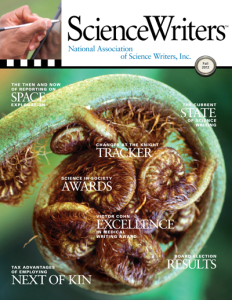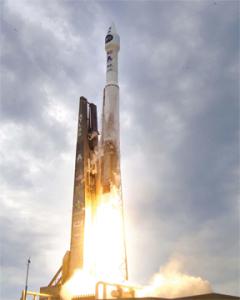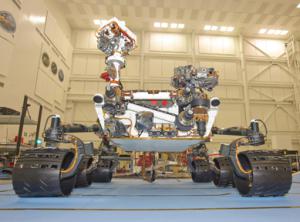Mars Curiosity Rover Landing Goes Viral
By Robert Lee Hotz
For seven exhilarating minutes this past August, the newsroom at the Jet Propulsion Laboratory crackled with the human electricity of telepresence. In those moments, hundreds of reporters, jammed elbow-to-elbow, were joined by a global audience drawn directly into the heartbeat of a breaking-news event.
“We were packed like sardines in the converted JPL museum, clanking away on our laptops,” recalled Associated Press science reporter Alicia Chang. “Space was so tight that it felt like every seat was the middle seat of an airplane. After hearing ‘touchdown confirmed,’ the room was abuzz with reporters filing to get the first word out.”The Curiosity landing mobilized a media flash mob.
Imaginative coverage gathered millions of people worldwide who tuned in remotely for the drama of a robot landing on Mars 154 million miles away. It was instant, transparent, and participatory. In this sense, the Mars landing was a media moment that highlighted the convergence of traditional and new multimedia ways of science coverage.
Officially, 400 reporters from about 100 media outlets came to JPL in the foothills of Pasadena and La Cañada Flintridge on the evening of Aug. 5 to cover the landing of NASA’s $2.5 billion Curiosity rover. Some media outlets that had covered previous Mars landings, such as USAToday, Houston Chronicle, San Jose Mercury News, and San Francisco Chronicle, were absent. Newer media sites like Boing Boing, Gizmodo, RedOrbit.com, and UniverseToday.com took seats vacated by layoffs and budget cuts at more old-line news outlets.
“There were a lot of new faces in the media here,” said news chief Jane Platt, at JPL’s media relations office.
There also were new demands on the JPL staff of about a dozen public affairs specialists. In the 10 days that the JPL newsroom was formally open for landing coverage, Platt and her colleagues fielded more than a thousand interview requests. They also fielded a new wave of multimedia and social media demands. “Reporters have a broader portfolio of things they have to do. When they come now, they bring multiple needs and requests,” Platt said. “We were immensely busy.”
The science reporters that night at JPL reached out to their audiences through almost every multimedia tool available and on every media platform, from print, video, and interactive blogs, to Facebook, YouTube, Google+, and Twitter.
“We’re not just pencil-pushing print reporters anymore,” said veteran aerospace reporter Todd Halvorson, who covered the landing for Florida Today and the Gannett chain of 83 newspapers and 23 television stations. It was his fourth Mars landing, but the first for which he was accompanied by a videographer.
As Curiosity braked through the thin Martian atmosphere, Halvorson was live online conducting an interactive blog with readers as far away as South Africa, while also taking notes for his paper’s more conventional breaking news bulletins and video stories. In the run-up to the landing, he had already filed a 30-minute video documentary, two in-depth Sunday feature stories, and a stream of daily updates.
All told, the Curiosity landing generated more than 10,000 news stories and blog reports. Those numbers, though, don’t adequately describe the rolling boil of moment-to-moment coverage of the Curiosity landing.
For Alan Boyle, digital science editor for NBCnews.com, who writes the Cosmic Log blog, the steady stream of updates blurred media formats into one unified information flow. “The story of the landing was continuously updated on our story page,” he said.” You wrote the story however it is best told, whether it is a news story, a blog posting, or a Twitter stream. They blend together nowadays.”Covering the landing for the Wall Street Journal, I shared that overcrowded JPL newsroom not just with other science reporters scrambling on deadline, but with online readers, Twitter followers, streaming video viewers, radio listeners, LinkedIn connections, Skype callers, Reddit questioners, and Google+ participants.
By JPL’s own accounting, the Curiosity landing generated 1.2 billion Twitter messages, 17.4 million Facebook hits, 3.7 million YouTube downloads, 36.4 million webcast streams, and, during minutes of the landing itself, 3.2 million viewers on Ustream.tv — more than the combined audiences of the cable news outlets.
In a very real way, readers were not just looking over my shoulder at my computer screen, but were in my pocket with my smartphone. In a sense, they were holding my pen and turning the pages of the notebook as I scribbled, making marginal notes on my news copy, through the comments section of the Journal’s website.
Through the live video-streaming of Ustream.tv, JPL online channels, and NASA’s own website, many of them even attended the same JPL press briefings that I did and eavesdropped on the same control-room commentary. In fact, more than one-third of all NASA’s webcast streams in the last eight years occurred in the 48 hours around the Curiosity landing — 36.4 million webcast streams in just two days, according to JPL social media manager Veronica McGregor. The traffic level peaked at 1.2 million webcast streams, double the previous record for a NASA event.
For my part, I filed an in-depth advance article on the mission and the problems facing NASA’s Mars exploration program, two video mini-documentaries on the Curiosity rover and its mission, radio interviews for the Journal’s own network, several news stories for the Journal’s website, then a front page story for our print editions. At 3 a.m., after the landing, with little to eat but a bag of “good-luck” mission peanuts, I found myself doing a live interview with our China bureau as part of the Journal’s web TV programming efforts.
In spare moments, I tweeted and posted on Facebook.
At times, though, it seemed my stiffest competition for public attention was not my colleagues at the New York Times, Washington Post, or Los Angeles Times, but McGregor and her social media team who artfully phrased tweets in the name of the Mars Curiosity robot rover.By design, they turned the intricate six-wheeled machine into a pert and lively heroine in an unfolding interplanetary drama. At the moment of touchdown, they tweeted through their @MarsCuriosity account: “Gale Crater. I am in you.” That 140-character message was relayed by other Twitter users 72,000 times.
“To put that in perspective, before the landing we would have considered 700 retweets outstanding,” McGregor said.
In all, the Curiosity rover’s Twitter followers rose from 120,000 people the day before the landing to more than 1.2 million people the following day. In the weeks since, other Curiosity tweets have been relayed and repeated tens of thousands of times.
At the same time, the mission website received 127 million page views — about 20 times the page views during a normal 48-hour period, according to McGregor.
In the end, it was a good news moment for a space agency beleaguered by budgets cuts and self-doubt. At the JPL post-landing press conference, dozens of exuberant, high-fiving NASA engineers and mission scientists in sky-blue, landing-team shirts wove their way between reporters in a congratulatory conga line.
“Every one of the folks came up and gave me a big hug,” said Halvorson. “They were exuding this pure joy.”
For science reporters too, it was an emotional moment.
“It was the relief of having a successful mission and not having to write about a failure,” said Boyle. “It was such a powerful emotional release that it leaves a mark on you.”
Robert Lee Hotz is the science columnist for the Wall Street Journal.





